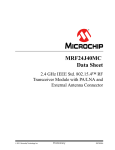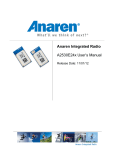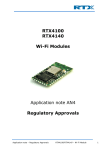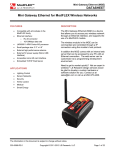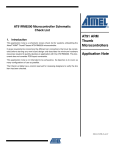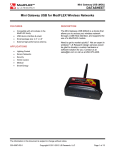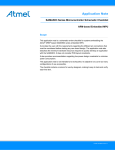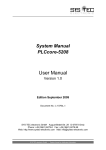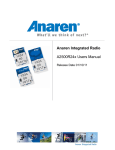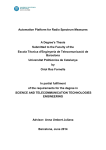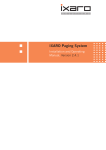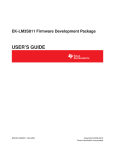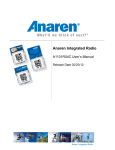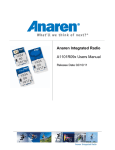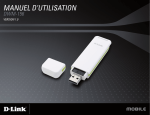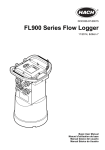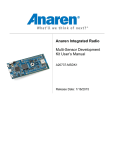Download A20737x User`s Manual
Transcript
Anaren Integrated Radio (AIR) Low-power RF modules, firmware & development tools that make it easy to ‘go wireless’ Anaren Integrated Radio A20737x User’s Manual Release Date: 01/16/15 Anaren, Inc. | 6635 Kirkville Road | East Syracuse, NY 13057 800.411.6596 | www.anaren.com/air | [email protected] Anaren Integrated Radio (AIR) Low-power RF modules, firmware & development tools that make it easy to ’go wireless’ THIS PAGE INTENTIONALLY LEFT BLANK iii USER’S MANUAL Models A20737A and A20737C Contents 1. Overview ..........................................................................................................................................................5 1.1. A20737A .....................................................................................................................................................5 1.2. A20737C ......................................................................................................................................................5 1.3. Features.......................................................................................................................................................6 1.4. Theory of Operation..................................................................................................................................6 1.5. Applications ...............................................................................................................................................8 2. Approvals and Usage .....................................................................................................................................9 2.1. Product Approvals ....................................................................................................................................9 2.1.1. USA-Federal Communications Commission (FCC) ...........................................................................9 2.1.1.1. FCC Labeling Requirements ..................................................................................................9 2.1.1.2. End User Manual ................................................................................................................... 10 2.1.1.3. RF Exposure ............................................................................................................................ 10 2.1.2. Canada (Industry Canada, IC) .......................................................................................................... 10 2.1.2.1. IC Labeling Requirements .................................................................................................... 12 2.1.2.2. RF Exposure ............................................................................................................................ 13 2.1.3. Europe (Conformité Européenne, ) ............................................................................................... 14 2.1.4. Bluetooth® Special Interest Group (SIG) ......................................................................................... 15 2.2. Potential Interference Sources ............................................................................................................... 15 2.2.1. WLAN ............................................................................................................................................... 15 2.2.2. Classic Bluetooth ............................................................................................................................... 15 2.2.3. Microwave Ovens ............................................................................................................................. 16 2.2.4. Other Interference ............................................................................................................................. 16 2.3. Approved Usage ..................................................................................................................................... 16 2.3.1. US and Canada ................................................................................................................................. 16 2.3.2. Europe ............................................................................................................................................... 17 2.3.3. Bluetooth ........................................................................................................................................... 17 3. Electrical Characteristics .............................................................................................................................. 19 3.1. Absolute Maximum Ratings .................................................................................................................. 19 3.2. Operating Conditions ............................................................................................................................. 20 3.3. Pin Out ...................................................................................................................................................... 20 3.4. Recommended Layout (dimensions in mm) ...................................................................................... 25 3.5. Power Supply Considerations ............................................................................................................... 26 4. Mechanical and Process ................................................................................................................................ 27 4.1. Radio Module Details ............................................................................................................................. 27 4.1.1. A20737A ........................................................................................................................................... 27 4.1.2. A20737C ........................................................................................................................................... 27 4.2. Packaging Details (dimensions in mm) ............................................................................................... 28 4.2.1. Matrix Tray Packaging ..................................................................................................................... 28 4.2.2. Tape-Reel Packaging ......................................................................................................................... 28 4.3. Soldering................................................................................................................................................... 29 4.3.1. Manual Mounting Procedure ........................................................................................................... 29 4.3.2. Automated Mounting Procedure ...................................................................................................... 30 Anaren Integrated Radio (AIR) Page 4 of 34 A20737x – User’s Manual Release Date 01/16/15 THIS PAGE INTENTIONALLY LEFT BLANK Anaren Integrated Radio (AIR) A20737x – User’s Manual Release Date 01/16/15 Page 5 of 34 1. Overview Anaren Integrated Radio (AIR) modules A20737A and A20737C are surface mount 2.4GHz RF transceivers incorporating Bluetooth® Smart technology that conforms to the Bluetooth v4.0 core specification. The A20737A has an integral antenna, and the A20737C uses an external antenna through a U.FL connector. These modules incorporate a crystal, 512-Kbit EEPROM, the required RF matching and filtering for regulatory compliance as well as filtering for noise reduction and sensitivity. They operate in the global unlicensed 2.4GHz ISM/SRD frequency band. The modules are ideal for achieving low power, long range wireless connectivity without having to deal with extensive protocol, RF, antenna design and regulatory compliance issues; as a result, costs and time to market can be reduced significantly. They are completely tested to provide consistent performance. The A20737x modules have received regulatory approvals for modular devices in the United States (FCC), Canada (IC) and Europe (ETSI). The modular approval allows the end user to place either an A20737A or an A20737C with an approved antenna inside a finished product without having to perform costly regulatory testing for an intentional RF radiator. Section 2.3 has information on the requirements for the end user/integrator to fulfill in order to use the modules without intentional radiator regulatory testing. The A20737x is based on the BCM20737 SoC transceiver from Broadcom. The BCM20737 combines the excellent performance of a leading RF transceiver with an integrated ARMR CortexTM-M3 based microprocessor core. All control lines are provided at module level for full control of the operation. The A20737x modules are available loaded with “BLE Stack” firmware from Broadcom and 512Kbit EEPROM for customer applications. The A20737x module measures 11 mm x 13 mm x 2.5 mm. All of the A20737x modules are footprint compatible with each other. 1.1. A20737A The A20737A has an integral antenna, providing high efficiency and near omni-directional radiation pattern. This approach offers the lowest system cost when the application allows collocation of radio and antenna. See Figure 6 - Figure 7 for more information on antenna location and enclosure considerations. 1.2. A20737C The A20737C has a compact antenna connector that allows for locating the antenna away from the module due to form/function or in order to exit a metal enclosure. Please see Table 1 for a list of approved antennas. Anaren Integrated Radio (AIR) Page 6 of 34 1.3. A20737x – User’s Manual Release Date 01/16/15 Features Features: 1.4. Benefits Summary: 2.4 GHz Bluetooth Smart technology 1.7 to 3.6 V operation Operating temperature -30oC to +85oC Integrated ARM Cortex-M3 microprocessor core 512-Kbit EEPROM Programmable output power control up to +3dBm Low current consumption (25 mA in RX and, 20mA @ 3 dBm) Typical sleep current is 2µA @3.3V Excellent receiver sensitivity, -94 dBm average with <1% BER Infrared modulator 10-Bit auxiliary ADC with nine analog channels Support for secure OTA Integrated LDO Supports SPI, I2C, PWM, UART, and GPIO peripheral interface protocols RoHS compliant Shielded package LGA footprint Very small package size: 11mm x 13mm x 2.5mm Approximate weight 0.5 grams 100% RF tested in production for repeatable performance Minimal RF engineering experience necessary Minimal Bluetooth Smart experience necessary Only requires a 2 layer Host PCB implementation FCC 15.247, IC RSS-210 and IC RSSGen certified Compliant with ETSI EN 300 328 No regulatory “Intentional radiator” testing required for integrating module into end product. Simple certification labeling replaces testing Theory of Operation The A20737x modules operate in the global 2.4 GHz ISM/SRD frequency band. They can be used to implement a variety of networks, including point to point, point to multi-point. Figure 1 and Figure 2 show the functionality of A20737A and A20737C, respectively. Both modules operate in a similar manner except with respect to the antenna, in that the A20737A module communicates through a built-in antenna, whereas the A20737C communicates through an external antenna attached to a U.FL connector. Anaren Integrated Radio (AIR) A20737x – User’s Manual Release Date 01/16/15 Page 7 of 34 Figure 1 The functionality of the A20737A, using an internal antenna Figure 2 The functionality of the A20737C, using an external antenna Anaren Integrated Radio (AIR) Page 8 of 34 A20737x – User’s Manual Release Date 01/16/15 The description of the functional blocks shown in Figure 1 and Figure 2 is given as follows: Antenna o The antenna couples energy between the air and the module. The integral antenna and the external monopole antenna, both centered at 2441.75 MHz, provide a near omni-directional antenna pattern with high efficiency such that the application will work in any direction. The end radiation pattern of the antenna depends on the ground plane, enclosure and installation environment. Matching & Filtering o Matching provides the correct loading of the transmit amplifier to achieve the highest output power as well as the correct loading for the receive LNA to achieve the best sensitivity. o Filtering removes spurious signals to comply with regulatory requirements, provides reduced susceptibility to power supply and digital noise, and filters out RF and high frequency noise from the communication data and control link. TX/RX Chain o The TX/RX chain handles transmitting and receiving of the communication data based on the radio register settings. It involves the coordination of several blocks including modulator, demodulator, AGC control, frequency synthesizer and frame control. Crystal o The crystal oscillator provides the necessary clock reference for the whole module operation. The A20737x modules use a 24 MHz crystal. Power Management o Power management ensures a stable supply for the internal functions, as well as providing means for a low power sleep mode. Table 1 Approved Antennas Item Part Number 1 2 3 Integral part of A20737A 66089-2406 66089-2430 1.5. Manufacturer Type Anaren Anaren Anaren Integral Antenna Monopole whip, 6 mm lead Monopole whip, 30 mm lead Gain (dBi) Applications Bluetooth Smart Systems Industrial Control and Monitoring Home/Building Automation Lighting Systems Low-Power Wireless Sensor Networks Sports monitoring, health & wellness Anaren Integrated Radio (AIR) 2 3 3 A20737x – User’s Manual Release Date 01/16/15 Page 9 of 34 2. Approvals and Usage The A20737x modules meet many national regulations for worldwide Industrial Scientific and Medical (ISM) radio bands use. In particular, the radio modules have been certified to the following standards. 2.1. 2.1.1. Product Approvals USA-Federal Communications Commission (FCC) The A20737x modules have been tested to comply with FCC CFR47 Part 15 sub-part C “Intentional Radiators” standard as well as Part 15 Sub-part B. The modules meet the requirements for modular transmitter approval as detailed in FCC public notice DA 00-1407 released in June 26, 2000. The modular transmitter approval eliminates the need to re-perform costly and time-consuming ‘intentional radiator’ testing when submitting an end product for certification. (15.19a3) The A20737x modules comply with part 15 of the FCC rules. Operation is subject to the following two conditions: (1) this device may not cause harmful interference, and (2) this device must accept any interference received, including interference that may cause undesired operation. Any changes or modifications not expressly approved by the party responsible for compliance could void the user’s authority to operate the equipment. 2.1.1.1. FCC Labeling Requirements The A20737x modules have been labeled with their own FCC ID number and if the FCC ID is not visible when the module is installed inside another device, then the outside of the finished product into which the module is installed must also display a label referring to the enclosed module. This exterior label can use wording such as the following: Contains Transmitter Module FCC ID: X7J-A14070701 -orContains FCC ID: X7J-A14070701 This device complies with Part 15 of the FCC Rules. Operation is subject to the following two conditions: (1) this device may not cause harmful interference, and (2) this device must accept any interference received, including interference that may cause undesired operation. Anaren Integrated Radio (AIR) Page 10 of 34 2.1.1.2. A20737x – User’s Manual Release Date 01/16/15 End User Manual The end user manual should include the following statement: This equipment has been tested and found to comply with the limits for a Class B digital device, pursuant to part 15 of the FCC Rules. These limits are designed to provide reasonable protection against harmful interference in a residential installation. This equipment generates, uses and can radiate radio frequency energy and, if not installed and used in accordance with the instructions, may cause harmful interference to radio communications. However, there is no guarantee that interference will not occur in a particular installation. If this equipment does cause harmful interference to radio or television reception, which can be determined by turning the equipment off and on, the user is encouraged to try to correct the interference by one or more of the following measures: Reorient or relocate the receiving antenna. Increase the separation between the equipment and receiver. Connect the equipment into an outlet on a circuit different from that to which the receiver is connected. Consult the dealer or an experienced radio/TV technician for help. 2.1.1.3. RF Exposure All transmitters regulated by FCC must comply with RF exposure requirements. OET Bulletin 65 Evaluating Compliance with FCC Guidelines for Human Exposure to Radio Frequency Electromagnetic Fields” provides assistance in determining whether proposed or existing transmitting facilities, operations or devices comply with limits for human exposure to Radio Frequency (RF) fields adopted by the Federal Communications Commission (FCC). The bulletin offers guidelines and suggestions for evaluating compliance. If appropriate, compliance with exposure guidelines for mobile and unlicensed devices can be accomplished by the use of warning labels and by providing users with information concerning minimum separation distances from transmitting structures and proper installation of antennas. The following statement must be included as a CAUTION statement in manuals and OEM products to alert users of FCC RF Exposure compliance: To satisfy FCC requirements the antenna used with this transmitter must not be co-located or operating in conjunction with any other antenna or transmitter except as permitted by FCC multitransmitter procedures. 2.1.2. Canada (Industry Canada, IC) The A20737x modules have been certified for use in Canada under Industry Canada (IC) Radio Standards Specification (RSS) RSS-210 and RSS-Gen. From section 3.2 RSS-Gen, Issue 3, December 2010, Modular Approval for Category I Equipment or Category II Equipment: Modular approval permits the installation of the same module in a host device or multiple host devices without the need to recertify the device. Equipment certification for a modular device may be sought for either Category I equipment or Category II equipment. Anaren Integrated Radio (AIR) A20737x – User’s Manual Release Date 01/16/15 Page 11 of 34 Transmitters designed as modules for the installation in a host device may obtain equipment certification as a modular device provided that the applicable RSS is met and the following conditions in this section are met.” In section 7.1.2 Transmitter Antenna, it has been mentioned that the user manuals for transmitters shall display the following notice in a conspicuous location: Notice: Under Industry Canada regulations, this radio transmitter may only operate using an antenna of a type and maximum (or lesser) gain approved for the transmitter by Industry Canada. To reduce potential radio interference to other users, the antenna type and its gain should be so chosen that the equivalent isotropically radiated power (e.i.r.p.) is not more than that necessary for successful communication. Avis: Sous la réglementation d'Industrie Canada, ce transmetteur radio ne peut fonctionner qu’en utilisant seulement une antenne d'un type et d’un maximum (ou moins) de gain approuvé pour l'émetteur par Industrie Canada. Pour réduire des potentielles interférences radio pour les autres utilisateurs, le type d'antenne et son gain doivent être choisis de sorte que la puissance isotrope rayonnée équivalente (PIRE) ne dépasse pas ce qui est nécessaire pour une communication réussie. In section 7.1.2 Transmitter Antenna, it states that the user manuals for transmitters equipped with detachable antennas shall also contain the following notice in a conspicuous location: Notice: This radio transmitter (IC: 8975A-A14070701) has been approved by Industry Canada to operate with the antenna types listed below with the maximum permissible gain and required antenna impedance for each antenna type indicated. Antenna types not included in this list, having a gain greater than the maximum gain indicated for that type, are strictly prohibited for use with this device. Avis: Cet émetteur radio (IC: 8975A-A14070701) a été approuvé par Industrie Canada pour fonctionner avec les types d'antennes énumérés ci-dessous avec le gain maximal admissible et l’impédance d'antenne requise pour chaque type d'antenne indiqué. Les types d'antennes ne figurant pas dans cette liste, ayant un gain supérieur au gain maximal indiqué pour ce type, sont strictement interdits pour l'utilisation avec cet appareil. Item numéro d'article Part Number Référence Integral part of A20737A Partie intégrante de A20737A Manufacturer Fabricant Type catégorie Gain (dBi) Gain Anaren Integral Antenna antenne intégrée 2 2 66089-2406 Anaren 3 66089-2430 Anaren 1 Monopole whip, 6 mm lead Antenne monopôle, longueur 6 mm Monopole whip, 30 mm lead Antenne monopôle, longueur 30 mm Anaren Integrated Radio (AIR) 3 3 Page 12 of 34 2.1.2.1. A20737x – User’s Manual Release Date 01/16/15 IC Labeling Requirements From section 3.2.1 RSS-Gen, Issue 3, December 2010, Labeling Requirements for the Host Device: “The host device shall be properly labeled to identify the modules within the host device. The Industry Canada certification label of a module shall be clearly visible at all times when installed in the host device, otherwise the host device must be labeled to display the Industry Canada certification number of the module, preceded by the words “Contains transmitter module”, or the word “Contains”, or similar wording expressing the same meaning.” From section 5.2, RSS-Gen, Issue 3, December 2010, Equipment Certification Numbers and Labels: “Every unit of Category I radio apparatus certified for marketing and use in Canada shall bear a permanent label on which is indelibly displayed the model number and Industry Canada certification number of the equipment model (transmitter, receiver, or inseparable combination thereof). Each model shall be identified by a unique combination of a model number and a certification number, which are assigned as described below in this section. The label shall be securely affixed to a permanently attached part of the device, in a location where it is visible or easily accessible to the user, and shall not be readily detachable. The label shall be sufficiently durable to remain fully legible and intact on the device in all normal conditions of use throughout the device’s expected lifetime. These requirements may be met either by a separate label or nameplate permanently attached to the device or by permanently imprinting or impressing the label directly onto the device. The label text shall be legible without the aid of magnification, but is not required to be larger than 8-point font size. If the device is too small to meet this condition, the label information may be included in the user manual upon agreement with Industry Canada.” Section 5.2 continues: “The model number is assigned by the applicant and shall be unique to each model of radio apparatus under that applicant’s responsibility. The model number shall be displayed on the label preceded by the text: “Model:”, so it appears as follows: Model: model number assigned by applicant” Anaren Integrated Radio (AIR) A20737x – User’s Manual Release Date 01/16/15 Page 13 of 34 Label: Contains/Contient IC: 8975A- A14070701 Notice: This device complies with Industry Canada licence-exempt RSS standard(s). Operation is subject to the following two conditions: (1) this device may not cause interference, and (2) this device must accept any interference, including interference that may cause undesired operation of the device. Avis: Cet appareil est conforme avec Industrie Canada RSS standard exempts de licence (s). Son fonctionnement est soumis aux deux conditions suivantes: (1) cet appareil ne peut pas provoquer d'interférences et (2) cet appareil doit accepter toute interférence, y compris les interférences qui peuvent causer un mauvais fonctionnement du dispositif. From section 7.1.4, RSS-Gen, Issue 3, December 2010, Radio Apparatus Containing Digital Circuits (ICES-003): “Radio apparatus containing digital circuitry which can function separately from the operation of a transmitter or an associated transmitter, shall comply with ICES-003. In such cases, the labeling requirements of the applicable RSS apply, rather than the labelling requirements in ICES-003.” For more information see: Industry Canada http://www.ic.gc.ca/ 2.1.2.2. RF Exposure All transmitters regulated by IC must comply with RF exposure limits as set forth in RSS-102, Issue 4, Section 4, “Exposure Limits”. Furthermore RSS-102, Issue 4, Section 2 “Certification Requirements”, provides assistance in determining the specific requirements for compliance. If appropriate, compliance with exposure guidelines for mobile and unlicensed devices can be accomplished by the use of warning labels and by providing users with information concerning minimum separation distances from transmitting structures and proper installation of antennas. The following statement must be included as a CAUTION statement in manuals and OEM products to alert users of IC RF Exposure compliance: Notice: To satisfy Industry Canada requirements the antenna used with this transmitter must not be co-located or operating in conjunction with any other antenna or transmitter except as permitted by Industry Canada’s multi-transmitter procedures Avis: Pour satisfaire aux exigences d'Industrie Canada l'antenne utilisée avec cet émetteur ne doit pas être colocalisée ni de fonctionner en conjonction avec une autre antenne ou un autre émetteur, sauf dans la mesure permise par les procédures multi-émetteurs de l'Industrie Canada Anaren Integrated Radio (AIR) Page 14 of 34 2.1.3. A20737x – User’s Manual Release Date 01/16/15 Europe (Conformité Européenne, ) The A20737x modules have been certified for use in European countries covered by ETSI regulations. The following tests have been performed and the module found to be compliant to the requirements: Test standard ETSI EN 300 328 V1.8.1 (2012-04) RF Output Power Duty Cycle Occupied Bandwidth RF Output Power Spectral Power Density Transmitter Spurious Emissions Receiver Spurious Emissions Electro-Static Discharge and RF Immunity (ETSI EN 301 489-17) RF Exposure (ETSI EN 62311:2008) Safety (IEC 60950-1:2005 and EN 60950-1:2006) A helpful document that can be a starting point in understanding the use of short range devices (SRD) in Europe is the European Radio Communications Committee (ERC) Recommendation 70-03 E, downloadable from the European Radio Communications Office (ERO) http://www.erodocdb.dk/Docs/doc98/official/pdf/REC7003E.PDF. The end user is responsible for ensuring compliance with harmonized frequencies and labeling requirements for each country the end device is marketed and sold. For more information see: Radio And Telecommunications Terminal Equipment (R&TTE) http://ec.europa.eu/enterprise/sectors/rtte/index_en.htm European Conference of Postal and Telecommunications Administrations (CEPT) http://www.cept.org/ European Telecommunications Standards Institute (ETSI) http://www.etsi.org/ European Communications Office (ECO) http://www.cept.org/eco Anaren Integrated Radio (AIR) A20737x – User’s Manual Release Date 01/16/15 2.1.4. Page 15 of 34 Bluetooth® Special Interest Group (SIG) The A220737A and A20737C modules have been certified and listed as Bluetooth Smart devices under the following categories: Model Number Type Declaration ID A20737A End Product D024702 Anaren AIR module with an embedded antenna based on Broadcom's BCM20737 transceiver A20737C End Product D024702 Anaren AIR module with a U.FL connector based on Broadcom's BCM20737 transceiver 2.2. Memo Potential Interference Sources The radio modules operate in the unlicensed ISM band, in which there are many other applications, e.g. WLAN, Classic Bluetooth and microwave ovens. This can cause interference that may, in certain conditions, prohibit radio communication. Some of the most common interferences are listed below: 2.2.1. WLAN Wireless Local Area Networks (WLANs) are divided into a number of overlapping channels. Figure 3 below shows the channels used by WLAN; for the US and Canada, only channels 1-13 may be used. Predominantly, channels 1, 6 and 11 are used to achieve non-overlapping channels. The user is therefore encouraged to select a channel scheme that also has channels falling in between, or entirely outside, WLAN channels. Using a detection scheme (clear channel assessment) will enable the user to find channels with minimal interference from WLAN devices. Figure 3 WLAN channels 2.2.2. Classic Bluetooth Classic Bluetooth divides the 2.402-2.480 GHz band into 79 channels, each of which is 1MHz wide. However, since Bluetooth changes channels rapidly (up to 1600 times a second), it is unlikely to cause continuous interference in a specific channel and can be overcome by implementing a simple acknowledge/retransmit functionality. Anaren Integrated Radio (AIR) Page 16 of 34 2.2.3. A20737x – User’s Manual Release Date 01/16/15 Microwave Ovens A typical microwave oven uses a self-oscillating magnetron with a duty cycle below 50%, because the tube is completely off for half of every AC mains cycle (8.33 ms in 60 Hz countries and 10 ms in 50 Hz countries). The frequency of the microwave oven changes cyclically within each AC mains synchronized on period, and is generally not predictable. The user is encouraged to have packet transmission durations less than half the AC mains period and implement an acknowledge/retransmit method. 2.2.4. Other Interference Systems similar to the user’s system may also exist within range and may also be a source of interference; some typical applications to consider are: 2.3. Alarm systems: These typically use low duty cycles and are therefore easy to avoid using acknowledge/retransmit methods Car alarms (internal motion sensors) Video surveillance: These are operated on a fixed channel, determined at installation time and can be avoided by using clear channel assessment. It may be useful to change the channel used by the video surveillance equipment. Approved Usage The A20737x modules have been approved for use in the US, Canada and Europe. The user is encouraged to use minimum power required to establish a link, thus minimizing interference. Changes or modifications to the module and/or operation outside the limits are prohibited and could void the user’s authority to operate the modules. 2.3.1. US and Canada Within the US and Canada, the A20737x modules have been approved for use as digitally modulated transmitters, for which they conform to the BW (a minimum of 500 kHz 6-dB BW for US, a maximum BW of 0.5% of the carrier frequency for Canada), power spectral density (max of 8 dBm / 3 kHz), total output power (max of 1W including the antenna gain) and spurious radiation (harmonics and others including the restricted bands) requirements. Table 2 shows approved frequencies of operations with the corresponding maximum output power values. These modules must be operated at or below the indicated power levels. Using the modules with higher power levels are prohibited, and will void the user’s authority to operate the modules under current FCC/IC certification. Table 3 shows available power levels from the device. Users are encouraged to use minimum power required to establish a link, thus minimizing interference and current consumption. Anaren Integrated Radio (AIR) A20737x – User’s Manual Release Date 01/16/15 Page 17 of 34 Table 2 Approved Power Levels for FCC/IC and ETSI Approved Frequencies (MHz) Max Output Power (dBm) A20737A 2402 - 2480 +3 A20737C 2402 - 2480 +3 Table 3 A20737x module available power levels and typical current consumptions Output Power(dBm) +3 -1 -5 -9 -13 -17 -21 -25 TX Current (mA) 20 15 13 12 11 10 9.7 9.5 RX Current (mA) 25 Idle Current (mA) 3.5 Please note that the specified current consumption numbers are for radio operation only and do not include other MCU peripherals. 2.3.2. Europe For Europe, the maximum allowed output power is 100mW with a spectral power density limit of 10mW/MHz. A20737x modules comply with the power spectral density requirements at their highest power level, therefore approved power levels given in Table 2 apply. Please refer to Table 3 for the available power levels from this module. 2.3.3. Bluetooth End products using A20737A or A20737C modules should have their own End Product Listing (EPL) through Bluetooth SIG in order to be advertised as Bluetooth Smart compliant. Please check the easy-to-follow guide located at http://www.bluetooth.org for more information. Anaren Integrated Radio (AIR) Page 18 of 34 A20737x – User’s Manual Release Date 01/16/15 THIS PAGE INTENTIONALLY LEFT BLANK Anaren Integrated Radio (AIR) A20737x – User’s Manual Release Date 01/16/15 Page 19 of 34 3. Electrical Characteristics 3.1. Absolute Maximum Ratings Under no circumstances shall the absolute maximum ratings given in Table 4 be violated. Stress exceeding one or more of the limiting values may cause permanent damage to the device. Caution! ESD sensitive device. Precaution should be used when handling the device in order to prevent permanent damage. Caution! This assembly contains moisture sensitive devices and requires proper handling per IPC/JEDEC J-STD-033 Table 4 Absolute Maximum Ratings Parameter Min Max Unit Supply Voltage (VDD_IN) -0.3 3.8 V Supply Voltage (VDD_RF) -0.3 1.4 V Voltage on any Digital Pin -0.3 VDD_IN+0.3 V -10 dBm 125 ˚C 260 ˚C According to IPC/JEDEC J-STD020D 4 kV According to JEDEC STD 22, method A114, Human body model RF Input Power Storage Temperature -40 Solder Reflow Temperature ESD -4 Condition/Note Anaren Integrated Radio (AIR) Page 20 of 34 3.2. A20737x – User’s Manual Release Date 01/16/15 Operating Conditions Table 5 Operating conditions Parameter Min Max Unit Supply Voltage (VDD_IN) 1.7 3.6 V Supply Voltage (VDD_RF) 1.14 1.26 V Temperature Range -30 +85 ˚C 3.3. Condition/Note Pin Out The A20737A and A20737C AIR modules share a common pin-out and foot print, thus enabling the use of the same application PCB layout for both. Below the pin-out is shown: Where applicable: NC = “No Connection”. Pin is NOT connected internally. DNC = “Do Not Connect”. Pin reserved for internal use, ensure mating footprint pads are isolated. GND = “Ground”. Connect the maximum number possible (minimum one for proper operation). Figure 4 A20737x Module pin-out (viewed from top side) Anaren Integrated Radio (AIR) A20737x – User’s Manual Release Date 01/16/15 Page 21 of 34 Table 6 A20737x Pin Descriptions With References To Chip Pins Pin Number Pin Name Pin Type Pin Description & Alternate Functions 1, 3, 6, 11, 30 GND Common Ground Connect to GND 2 DNC 4 NC Do Not Connect. Connecting this pin to anything will significantly affect the performance of the module and may void the end users' right, under FCC, to operate the module Pin is not internally connected P15 Digital I/O 7 UART_RX Digital input, PD 8 UART_TX Digital output, PU 9 SDA I/O, PU 10 SCL I/O, PU 12 TMC Digital input, PD 13 RST_N I/O, PU 5 BCM20737 PIN - Floating input after POR State - GPIO: P15 - A/D Converter input - IR_RX - 60 Hz main - UART serial input - Serial data input for the HCI UART interface with a 10kΩ internal pull down resistor. Leave unconnected if not used - GPIO3 - UART serial output - Serial data output for the HCI UART interface. Leave unconnected if not used - GPIO2 - Data signal for an external I2C device with a 10kΩ internal pull up resistor - SPI_1: MOSI (master only) - GPIO0 - CTS - Clock signal for an external I2C device with a 10kΩ internal pull up resistor - SPI_1: SPI_CLK (master only) - GPIO1 - RTS 31 12 13 15 16 Test mode control with a 10kΩ internal pull down resistor. Pull high for test mode. 17 Active-low system reset with open-drain output & internal pull-up resistor 18 Anaren Integrated Radio (AIR) Page 22 of 34 Pin Number 14 15 16 17 18 19 A20737x – User’s Manual Release Date 01/16/15 Pin Name P0 P1 P3 P2 P4 P8/P33 Pin Type Pin Description & Alternate Functions BCM20737 PIN - Floating input after POR State - GPIO: P0 - A/D Converter input - Peripheral UART: puart_tx - SPI_2: MOSI (master and slave) - IR_RX - 60 Hz main - Not available during TMC=1 19 - Active-low write-control for the internal EEPROM with a 10kΩ internal pull up resistor - GPIO: P1 - A/D converter unit - Peripheral UART: puart_rts - SPI_2: MISO (master and slave) - IR_TX 20 Digital I/O - Floating input after POR State - GPIO: P3 - Peripheral UART: puart_cts - SPI_2: SPI_CLK (master and slave) 21 Digital I/O - Floating input after POR State - GPIO: P2 - Peripheral UART: puart_rx - SPI_2: SPI_CS (slave only) - SPI_2: SPI_MOSI (master only) 22 Digital I/O - Floating input after POR State - GPIO: P4 - Peripheral UART: puart_rx - SPI_2: MOSI (master and slave) - IR_TX 23 Digital I/O - Floating input after POR State - A/D converter input - P8 + GPIO: P8 + External T/R switch control: ~tx_pd - P33 + GPIO: P33 + SPI_2: MOSI (slave only) + Auxiliary clock output: ACLK1 + Peripheral UART: puart_rx 24 Digital I/O Digital input, PU Anaren Integrated Radio (AIR) A20737x – User’s Manual Release Date 01/16/15 Pin Number 20 21 22 23 24 Pin Name Page 23 of 34 Pin Type Pin Description & Alternate Functions BCM20737 PIN P32 Digital I/O - Floating input after POR State - GPIO: P32 - A/D converter input - Peripheral UART: puart_tx - SPI_2: SPI_CS (slave only) - SPI_1: MISO (master only) - Auxiliary clock output: ACLK0 P25 Digital I/O - Floating input after POR State - GPIO: P25 - Peripheral UART: puart_rx - SPI_2: MISO (master and slave) 26 Digital I/O - Floating input after POR State - GPIO: P24 - Peripheral UART: puart_tx - SPI_2: SPI_CLK (master and slave) - SPI_1: MISO (master only) 27 Digital I/O - Floating input after POR State - A/D converter input - P14 + GPIO: P14 + PWM2 - P38 + GPIO: P38 + SPI_2: MOSI (master and slave) + IR_TX 30 Digital I/O - Floating input after POR State - A/D converter input - P13 + GPIO: P13 + PWM3 - P28 + GPIO: P28 + LED1 + IR_TX + PWM2 + Current: 16 mA 29 P24 P14/P38 P13/P28 Anaren Integrated Radio (AIR) 25 Page 24 of 34 Pin Number 25 Pin Name P12/P26/ XO32 26 P11/P27/ XIN32 27 VDD_IN 28 LDO_OUT 29 VDD_RF A20737x – User’s Manual Release Date 01/16/15 Pin Type Pin Description & Alternate Functions BCM20737 PIN Digital I/O - P12 + GPIO: P12 + A/D converter input + Low-power oscillator (LPO) output - P26 + GPIO: P26 + PWM0 + SPI_2: SPI_CS (slave only) + SPI_1: MISO (master only) + Current: 16 mA 32 Digital I/O - P11 + GPIO: P11 + A/D converter input + Low-power oscillator (LPO) input - P27 + GPIO: P27 + PWM1 + SPI_2: MOSI (master and slave) + Current: 16 mA 1 Power (Analog) Power (output) Power (Analog) I/O pad and core supply (1.7 - 3.6V) LDO Output (1.2V ) RF front-end supply (1.14 - 1.26V) Anaren Integrated Radio (AIR) 3 A20737x – User’s Manual Release Date 01/16/15 3.4. Page 25 of 34 Recommended Layout (dimensions in mm) Figure 5 Recommended PCB footprint. Anaren Integrated Radio (AIR) Page 26 of 34 A20737x – User’s Manual Release Date 01/16/15 Figure 6 Mounting the module in a corner Figure 7 Mounting the module along an edge “No GND” area is optional for A20737C modules. It may still be provided for compatibility with the internal antenna version (A20737A). 3.5. Power Supply Considerations Noise on the power supply line reduces the sensitivity of a receiver and can modulate onto a transmitters signal, both of which causes a degradation of link quality and hence a reduction in range. The A20737x modules have integral noise reduction from power supply to the internal biasing pins, consisting of ferrite beads and decoupling capacitances. This arrangement will take care of most supply voltage noise. For optimal performance in particular noisy environments (switching regulators, motor controls, etc.) it may be necessary to add additional noise reduction means, which can consist of a low noise LDO or additional LC filtering. Note that if operated from a battery source, there is no need for additional noise reduction. The A20737x modules have internal LDO which provides 1.2V voltage. The output of this LDO is brought out to pin 28. Also, a separate input voltage pin (pin 29) is provided for convenience to customers who wish to supply 1.2V to the RF circuitry externally. In case this option is not desired, pin28 and pin29 should be tied together to power the RF circuitry. Anaren Integrated Radio (AIR) A20737x – User’s Manual Release Date 01/16/15 Page 27 of 34 4. Mechanical and Process 4.1. 4.1.1. Radio Module Details A20737A Figure 8 A20737A Dimensions 4.1.2. A20737C Figure 9 A20737C Dimensions Anaren Integrated Radio (AIR) Page 28 of 34 4.2. A20737x – User’s Manual Release Date 01/16/15 Packaging Details (dimensions in mm) AIR modules are available in Matrix Tray and Tape & Reel packaging for high-volume assembly. Details of packaging provided below: 4.2.1. Matrix Tray Packaging Figure 10 A20737AxxGM and A20737CxxGM Matrix Tray Packaging Detail (36/Tray) 4.2.2. Tape-Reel Packaging Figure 11 A20737AxxGR and A20737CxxGR Tape-Reel Packaging Detail (500/Reel) Anaren Integrated Radio (AIR) A20737x – User’s Manual Release Date 01/16/15 4.3. Page 29 of 34 Soldering AIR Modules may be mounted either manually (for prototyping or low volume production), or automatically for high-volume production. A no-clean tin/silver/copper (SAC) solder is recommended, however lead-based, no-clean pastes may also be used. CAUTION: AIR Modules are designed for no-clean fluxes only. DO NOT use waterbased fluxes that require aqueous cleaning after solder. Spot cleaning with a flux remover and toothbrush may be performed with care. 4.3.1. Manual Mounting Procedure The recommended soldering method is reflowing of a paste solder on a hot plate. This method works provided the bottom of the board where the AIR module is to be mounted is accessible, and there are no bottom-side components in the way. An aluminum or copper block may be placed on the hot plate surface to transfer heat to a localized area on the board where the AIR module is mounted - Set the hot plate to the reflow temperature solder manufacturer’s recommended Apply solder paste to the pads on the board receiving the AIR module Place the AIR module carefully onto the dispensed solder Using tweezers or another holding device, carefully place board with AIR module onto the hot plate surface (or metal block) Apply heat until reflow occurs, per solder paste manufacturer’s recommendations Carefully remove the board and place on a heat-resistant surface to cool Check assembly electrically to confirm there are no open or short circuits Anaren Integrated Radio (AIR) Page 30 of 34 4.3.2. A20737x – User’s Manual Release Date 01/16/15 Automated Mounting Procedure The AIR module recommended solder reflow profile is based on IPC/JEDEC J-STD-020. Anaren Integrated Radio (AIR) A20737x – User’s Manual Release Date 01/16/15 Page 31 of 34 Anaren Integrated Radio (AIR) Page 32 of 34 A20737x – User’s Manual Release Date 01/16/15 DOCUMENT HISTORY Date 09/19/14 11/18/14 Author Sula Sula 11/26/14 Sula 12/16/14 Subramanian 01/16/15 Sula Change Note No./Notes Initial Draft Some formatting and minor changes Added Bluetooth declaration ID, updated module footprint Updated ETSI information and corrected some more mistakes Some formatting and minor changes Anaren Integrated Radio (AIR) THIS PAGE INTENTIONALLY LEFT BLANK Attach distributor contact information here If you have additional questions, need samples, or would like a quote – please email the AIR team at [email protected] . For a full list of our franchised distributors, please visit our website: http://www.anaren.com/air/ Anaren Microwave, Inc. 6635 Kirkville Road East Syracuse, NY 13057 Tel: +1 315 432 8909 +1 800 411 6596 Fax: +1 315 432 8970 Anaren Microwave (Europe), Inc. 12 Somerset House, Suite 16 & 17 Hussar Court, Waterlooville Hampshire, England P07-7SG Tel: +44 2392 232392 Fax: +44 2392 251369 Anaren Communication Suzhou Co. Ltd. Bldg 3, No. 1 LongHui Street Suzhou Industrial Park Suzhou 215122, PR China Tel: +86 512 6274 9282 Fax: +86 512 6274 9283




































